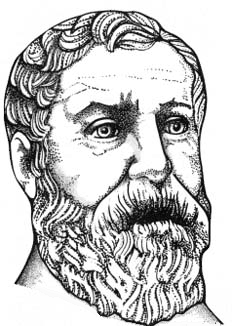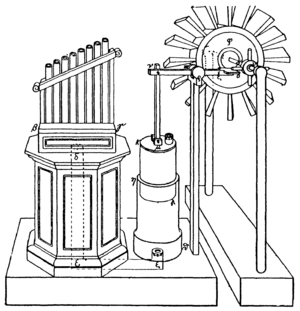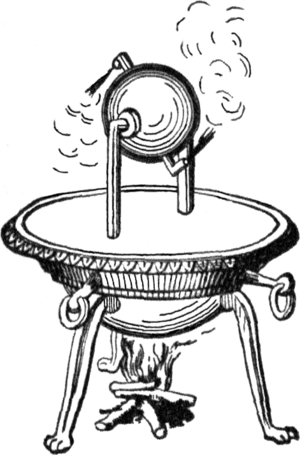Hero of Alexandria facts for kids
Quick facts for kids
Heron of Alexandria
|
|
|---|---|
| Ἥρων | |

17th-century German depiction of Heron
|
|
| Citizenship | Alexandria, Roman Egypt |
| Known for | Aeolipile Heron's fountain Heron's formula Vending machine |
| Scientific career | |
| Fields | Mathematics Physics Pneumatic and hydraulic engineering |
Heron of Alexandria (also known as Hero) was a brilliant Greek mathematician and engineer. He lived in Alexandria, Egypt, during the Roman era, around 60 AD. Many people consider him the greatest experimenter of ancient times. His work shows the amazing scientific knowledge of the Hellenistic period.
Heron wrote about a steam-powered device called an aeolipile. It's sometimes called the "Hero engine." He also created one of the first windwheels, which used wind power on land. This was a very early example of using wind to do work. He was also a follower of the idea of atomism, which means he believed everything was made of tiny, unseen particles. In his book Mechanics, he described tools called pantographs, which are used to copy drawings.
In math, Heron is famous for Heron's formula. This formula helps you find the area of any triangle if you only know the lengths of its three sides.
Sadly, many of Heron's original writings and designs have been lost. But some of his works were saved. We know about them from old manuscripts and translations into Latin or Arabic.
Life and Work
Heron likely taught at the Musaeum in Alexandria. This famous center of learning included the amazing Library of Alexandria. His writings often look like notes for classes he taught. These classes covered mathematics, mechanics, physics, and pneumatics (the study of air and gases).
Some people think Heron's work on automated machines was an early step in cybernetics. This is a modern field that studies how systems control themselves.
Amazing Inventions
Heron described how to build the aeolipile. This was a rocket-like engine that worked using steam. It's known as the first recorded steam engine, even though another writer, Vitruvius, mentioned a similar device earlier. Heron described it almost 2,000 years before the Industrial Revolution began!
He also invented another engine. This one used hot air from a fire to push water out of a sealed container. The weight of the water then pulled on a rope, which could open temple doors.

- First Vending Machine: Heron created the first vending machine. When you put a coin into a slot, a certain amount of holy water would come out. This invention was in his book Mechanics and Optics. The coin would land on a pan connected to a lever. This lever opened a valve, letting water flow. The pan would tilt until the coin fell off. Then, a counter-weight would close the valve.
- Wind-Powered Organ: He also invented a wind-wheel that powered an organ. This was the first time in history that wind was used to power a machine.
- Theatre Mechanisms: Heron designed many clever devices for the Greek theatre. One was a fully mechanical play that lasted almost ten minutes. It worked using a system of ropes, knots, and simple machines. A rotating cogwheel made everything move. He even made the sound of thunder by dropping metal balls onto a hidden drum at just the right time.
- Force Pump: Heron described the force pump. This device was widely used in the Roman world. One important use was in fire engines to put out fires.
- Syringe Device: He also described a syringe-like tool. It could control how air or liquids were delivered.
- Shortest Path of Light: In the study of light (optics), Heron came up with an important idea. He said that light travels the shortest possible path between two points. This idea was later expanded by other scientists.
- Heron's Fountain: He invented a special fountain that works on its own. It uses self-contained water pressure to keep the water flowing. It's still called Heron's fountain today.
- Self-Propelled Cart: Heron designed a cart that moved by itself. It was powered by a falling weight and strings wrapped around its axle.
- Early Thermometer: Heron knew that some things, like air, expand when heated and shrink when cooled. He showed this with a closed tube partly filled with air. One end of the tube was in water. As the air expanded or contracted, the water level in the tube would move. This was an early step towards inventing the thermometer.
- Self-Filling Wine Bowl: He created a wine bowl that refilled itself using a float valve.
Mathematics Discoveries
Heron described a way to calculate the square root of a number. This method is now known as Heron's method. However, he is most famous for Heron's formula. This formula lets you find the area of a triangle if you only know the lengths of its sides. He also found a way to calculate cube roots.
He also designed a "shortest path algorithm." Imagine two points, A and B, on one side of a straight line. Heron's method helps you find a point C on that line so that the distance from A to C and then to B is the shortest possible.
In solid geometry, the Heronian mean is a type of average. It can be used to find the volume of a frustum (the bottom part) of a pyramid or cone.
See also
 In Spanish: Herón de Alejandría para niños
In Spanish: Herón de Alejandría para niños
- Heronian triangle
- Heronian mean


